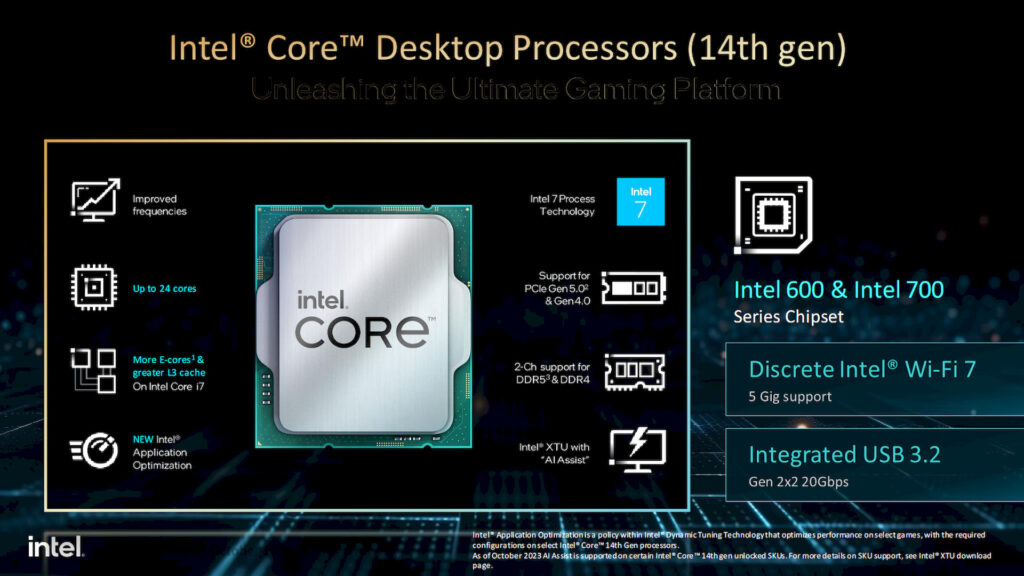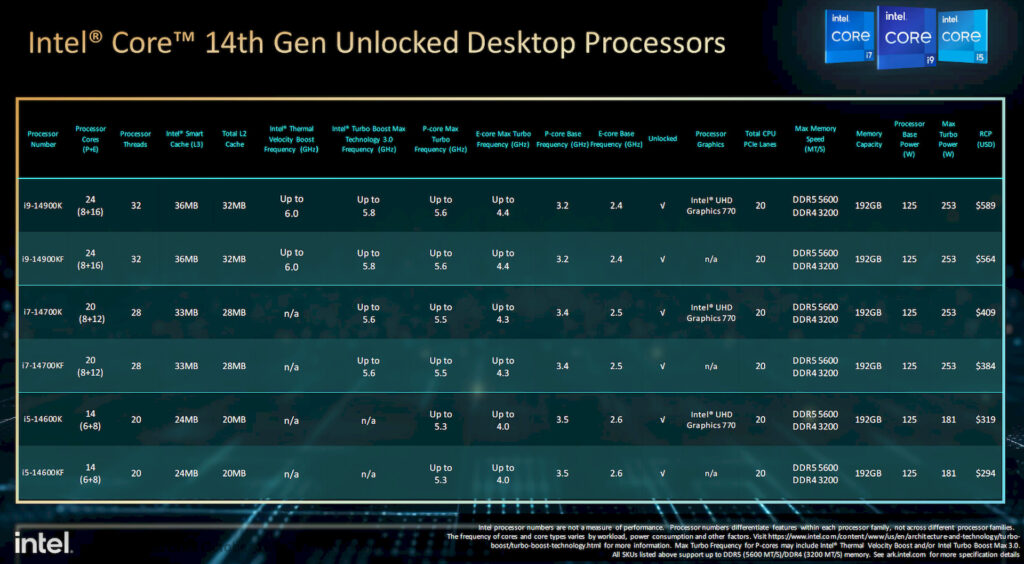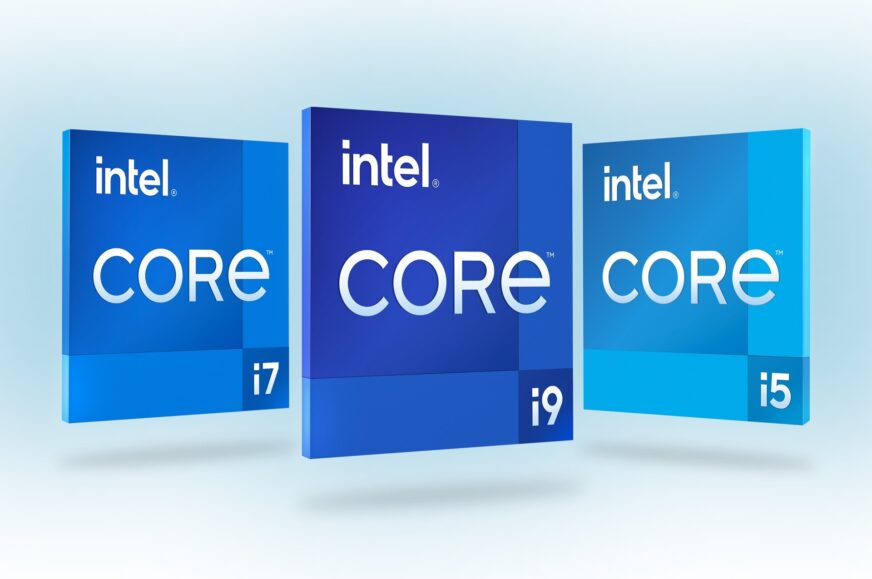Raptor Lake Refresh for desktop is here. 125W SKUs out today
Intel didn’t unveil the new Raptor Lake Refresh or 14th-generation Core desktop processors at September’s Intel InnovatiOn conference, as we expected (they only made a very marginal appearance). But now this new generation of CPUs for the LGA 1700 platform has been officially announced: we have the final specs and suggested prices for the six K/KF series models that are now going on sale. They should be in stores from today.
Core 14th generation for desktop (it should be the last generation with this marking, next time Intel will switch to Core Ultra) are what is considered a refresh. This means that these are not brand new chips, but reused or revised chips from the previous generation, or in this case, chips from the 12th and 13th generation Alder Lake and Raptor Lake. So these are 7nm processors (manufactured using the Intel 7 node) with up to 8 big P-Core cores and 16 little E-Core cores, for a total of 32 threads. However, compared to previous generations, they offer slightly higher performance due to the higher clock speeds achieved.
This month, Intel is releasing the first six models, all 125W K-series SKUs with unlocked multipliers that are designed for enthusiasts and overclockers. The remaining models will probably come out next year (first half). Unlike previous generations, no new chipset will come out with the processors. You can still use boards with Intel’s 600 and 700 generation chipsets, of course, they will probably just need a BIOS update.

6 GHz!
The lineup will be headlined by the Core i9-14900K (priced at 589 USD excluding tax/675 EUR incl. VAT) and its brother the Core i9-14900KF (564 USD/646 EUR), which has identical specs, only with the Intel UHD 770 integrated GPU disabled. This CPU has 8 P-Cores and 16 E-Cores (32 threads in total) with 36MB L3 cache. The base clock speed is 3.2 GHz for the P-Cores and 2.4 GHz for the E-Cores, with the maximum boost reaching 6.0 GHz for the P-Cores and 4.4 GHz for the E-Cores. This means that the processor’s clock speed is up to 200 MHz (for P-Cores, whereas E-Cores’ maximum boost is only 100 MHz higher) higher than last year’s Core i9-13900K and matches the maximum boost of the special edition Core i9-13900KS. Along with it, these are the first ever processors to reach a clock speed of 6000 MHz.
This maximum clock speed is achieved using Thermal Velocity Boost (without it, it would be only 5.8 GHz) and Turbo Boost Max 3.0, i.e. on one or two preferred cores (otherwise the maximum is 5.6 GHz). According to Intel, this will be the most powerful processor for PCs, but it’s probably better to wait to see what independent reviews have to say.

Power draw, on the other hand, is said to have remained the same, or at least Intel lists the same specs. The TDP is 125W and the maximum turbo power draw under load is 253 W. It should be said here that many especially more expensive enthusiast boards may ignore this or offer modes where the power limit is uncapped. It is therefore possible that we will again see cases where the power draw climbs higher (and may then be relatively higher even compared to the i9-13900K).
More cores for mid-range i7 models
While for the most part, Raptor Lake Refresh only increases the clock speeds, Core i7 models are the exception. While in the 13th generation these were 24-thread CPUs (8+8 cores), Intel changed the configuration of the refresh SKUs to 8 P-Cores and 12 E-Cores, so the Core i7-14700K (409 USD/467 EUR) and the Core i7-14700KF (384 USD/440 EUR) have 28 threads (and 33MB of L3 cache) and should see improved multithreaded performance. These processors will therefore be significantly closer to the top-end Core i9 models than before, making them an interesting option.
Here as well, the maximum turbo increased by 200 MHz on the big and 100 MHz on the little cores, but perhaps because of the increase in the number of threads the base clock frequencies were not changed. Thus, the P-Core clock speed is 3.4–5.6 GHz and the E-Core clock speed is 2.5–4.3 GHz. The maximum boost of 5.6 GHz is again available on the preferred cores (via Turbo Boost Max 3.0), otherwise the maximum is just 5.5 GHz. Here too, the TDP stays 125 W and the official maximum turbo power draw is 253 W.

Core i5 still at 6+8 cores
No such upgrade happened with the i5s, the Core i5-14600K (319 USD/366 EUR) and the Core i5-14600KF (294 USD/337 EUR). These remain at 6 P-Cores and 8 E-Cores (20 threads in total) with 24MB L3 cache, but again the clock speeds have increased by up to 200 MHz (100 MHz for the E-Cores). The clock speed of the big cores is thus 3.5–5.3 GHz, the clock speed of the E-Cores is 2.6–4.0 GHz. Intel has kept the same power draw limits for these models as in the previous generation. This means 125W TDP and 181W maximum turbo power draw.
Raptor Cove architecture with 2MB L2 cache in all K-processors
All six models are based on the B0 stepping, so the Core i5s as well use dies physically containing 8+16 cores and Raptor Lake architecture. The big cores therefore have 2MB of L2 cache in all these models and the E-Core clusters share 4MB of L2 cache.
The other aspects of the processors are unchanged from the 13th generation due to the fact that it is a refresh. The K processors have an integrated Intel UHD Graphics 770 GPU with 256 shaders (clock speeds are 1650, 1600, and 1550 MHz respectively depending on the processor i9/i7/i5 classification). There’s the same integrated PCIe 5.0×16 controller for dedicated graphics cards, while a single PCIe 4.0×4 interface is provided for the SSD. Officially supported memory is DDR5-5600 and DDR4-3200 (unchanged from the 13th generation).
+200 MHz with P-Cores, +100 MHz with E-Cores
In short, these processors always have 200 MHz higher maximum P-Core boosts than the corresponding 13th generation models (E-Core boosts are always 100 MHz higher). As a result, you should get 3.4–3.9% better single-threaded performance with them, and probably also similarly better results in games, as those should respond to ST performance as well.
Multi-threaded performance is the bigger question. When the CPUs are kept within the prescribed Maximum Turbo Power values, they could theoretically hit the power draw limit. On the other hand, the Core i7 should show more cross-generational improvement than the Core i9 and i5 in multi-threaded applications like rendering or video encoding thanks to the four extra threads. But the real extent of the progress will only be properly revealed in independed reviews that should be out today.

In-store availability this day
Yesterday, October 16, Intel lifted the embargo on the so-called “unboxing” and presentation of these processors, their models and parameters. Direct physical availability started today (Oct 17) probably at 15:00 CET. Reviews have also come out at this time.
There had been speculation that these processors would be more expensive than previous generations, but that doesn’t seem to have been confirmed, and specific models (i.e., the Core i9 “KF”) always have the same suggested international (USD) prices as the previous 13th generation. Or, rather, the same prices as the 13th generation SKUs launched at last year. But in the meantime, the 13th Gen processors have often gotten cheaper in stores, so in practice the early 14th Gen will could end up being a bit more expensive.
Source: Intel
English translation and edit by Jozef Dudáš
⠀







